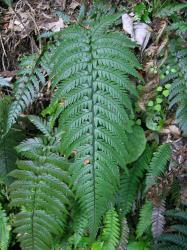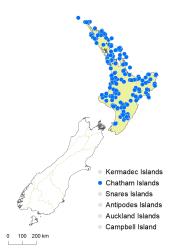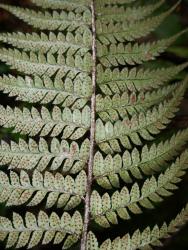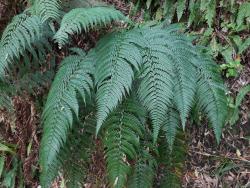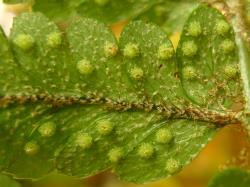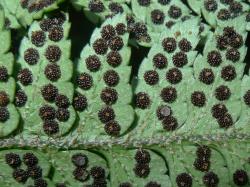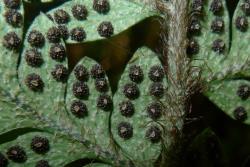- ≡ Aspidium wawranum Szyszyl. in Wawra von Fernsee, Itin. Princ. S. Coburgi 2, 126, t. 15 (1888) – as Aspidium wawraeanum
Rhizomes erect, densely scaly. Rhizome scales narrowly ovate, 11–17 mm long, 1–3 mm wide, bicolorous with dark centres and pale margins, margins toothed. Fronds 275–1270 mm long. Stipes 105–700 mm long, pale brown, abundantly scaly throughout; scales at very base similar to those of rhizome; those at mid-stipe linear, blackish-brown, apices filiform, margins with a few protrusions, bases densely fimbriate; those from the stipe/rachis junction 40–120 μm wide at mid-length. Rachises pale brown, sulcate, narrowly winged only at distal end, abundantly scaly. Laminae 2-pinnate or rarely 3‑pinnate proximally, ovate or elliptic, 150–730 mm long, 60–330 mm wide, olive-green to blue-green adaxially, paler green abaxially, coriaceous, bearing abundant pale brown or colourless scales on abaxial costae and lamina surfaces, sparsely scaly on adaxial costae, ± glabrous on adaxial lamina surfaces. Primary pinnae in 12–35 pairs below pinnatifid apex, slightly overlapping distally, narrowly ovate; the longest at or near the middle, 35–170 mm long, 13–55 mm wide, apices acuminate, bases stalked; costae narrowly winged throughout. Secondary pinnae decreasing very gradually in length along the primary pinna to the distal end; the longest secondary pinnae oblong or ovate, 8–40 mm long, 5–12 mm wide, apices rounded, margins entire to deeply serrate, bases adnate or stalked. A few tertiary segments sometimes present on proximal pinnae, ovate, up to 9 mm long and 4 mm wide. Sori round, medial or nearer margin than costa; indusia round, 0.7–1.5 mm diameter, with inconspicuous dark central area (1–17% of surface area). Mean spore size 40–48 μm long, 29–36 μm wide.
Polystichum wawranum is distinguished by the scales at the stipe/rachis junction that are very narrow, blackish-brown, hair-like and abundantly fimbriate at their bases (Perrie et al. 2003a, fig. 5). The indusia are either concolorous or have tiny black centres (ibid., fig. 6). The laminae are olive- to blue-green on the adaxial surfaces and paler green abaxially. P. wawranum is likely to be confused only with P. neozelandicum, which has wider scales (40–120 μm wide, cf. 135–570 μm wide), indusia with larger dark centres, and larger spores (40–48 μm long, 29–36 μm wide, cf. 46–58 μm long, 36–45 μm wide).
Polystichum wawranum is distinguished from most of the naturalised species by its lack of bulbils, from P. vestitum and P. sylvaticum by its concolorous rather than bicolorous scales at the stipe/rachis junction, from P. cystostegia by its flat rather than inflated indusia, and from P. oculatum by its much narrower scales.
North Island: Northland, Auckland, Volcanic Plateau, Gisborne, Taranaki, Southern North Island.
Three Kings Islands, Chatham Islands.
Altitudinal range: 0–880 m.
Polystichum wawranum occurs in lowland and montane regions throughout the North Island from Te Paki to Ōtaki. It ranges from sea level up to 880 m in the Raukūmara Ranges. It extends also to the Three Kings Islands and Chatham Islands, but does not reach the South Island.
Polystichum wawranum occurs in kauri, podocarp, broadleaved, beech and coastal forest, under mānuka and kānuka, amongst flax and coastal scrub, and on grassy slopes, usually in drier and more open conditions. It is found on coastal cliffs, hillsides, tracksides, roadside banks, streambanks and river terraces, in gullies, and on the forest floor. It grows on greywacke and limestone substrates.
There is evidence that P. wawranum hybridises with P. neozelandicum and P. vestitum (Perrie et al. 2003a).
n = c. 82 (Perrie et al. 2003a).



